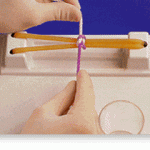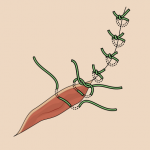In two recent posts I recommended some great video tutorials for suturing and for instrument tying. This post will focus on learning how to tie one and two handed knots in the operating room. As with previous skills, it is very important that medical students learn to tie surgical knots early in their training. Let me offer one experience from medical school to illustrate this fact. This is a true story.
After finishing rounds with the residents on my OB rotation I was assigned to work in the OR with the chief of benign gynecology surgery at a community hospital. He also happened to be the rotation coordinator and was responsible for my grade and evaluation. The first case was an open tubal ligation. As the case was ending the attending turned to me and said, “hey, we have to close the fascia, can you tie knots?” Luckily, I knew quite well how to tie. I picked up the suture and threw a few two handed knots down. My attending was seriously impressed and told everyone on the team. He gave me a raving evaluation and spoke specifically about how I was “well prepared for the OR.” So, take it from me, learn these knots! Always remember Rule #1: tie square knots, not granny knots! Two throws are required to complete the knot.
1. The two handed knot. This is the knot that you will actually use in the OR. Most surgeons never tie one-handed knots and some even forbid them. So, this should be your bread and butter. After watching a few tutorial videos I am convinced that this is the best. It comes from the University of Texas at Houston and walks you through the basics. The audio is very good, so find some earphones. Always remember that a square not requires two throws to be completed.
2. The one handed knot: This is a more confusing knot and far less high yield because very few surgeons ever use it or expect it. It is notoriously difficult to teach and to learn. The best video I have found is shown below. Unlike the previous video, there is not audio to walk you through the knot. Rather, the knot is completed slowly and each difficult section is repeated. Remember, you must tie two throws to make a complete square knot. This is important when tying a one handed knot because the two throws are completed using two different techniques.
Finally, there is more than one way to tie a square knot. Here is one more video that demonstrates the two handed and one handed method clearly. Similar to the second video, there is no audio. Go get some gloves and some suture and practice along with this video.








 My name is Andrew and I am a first year resident training to be an ophthalmologist. I created ShortWhiteCoats to provide medical students, residents, and the public with all the information I spent so many hours looking for during medical school.
My name is Andrew and I am a first year resident training to be an ophthalmologist. I created ShortWhiteCoats to provide medical students, residents, and the public with all the information I spent so many hours looking for during medical school.







